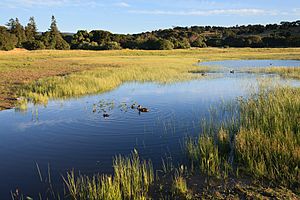Lake Lagunita facts for kids
Quick facts for kids Lake Lagunita |
|
|---|---|

Lake Lagunita in the winter
|
|
| Location | Stanford, California |
| Coordinates | 37°25′24″N 122°10′34″W / 37.4232°N 122.1760°W |
| Type | Dry lake |
| Basin countries | United States |
| Surface elevation | 131 ft (40 m) |
Lake Lagunita, often called Lake Lag, is a special, man-made lake at Stanford University in California. It's located on the western side of the campus, close to some student homes. This lake was first created around the 1870s to help water the Palo Alto Stock Farm, which was a large farm for animals.
For many years, during winters with lots of rain, the lake would fill up. Water was brought in from San Francisquito Creek to make it about three feet deep. This allowed students to use the lake for fun activities. However, since the late 1990s, the lake has not been filled on purpose. This is because of issues with the lake's walls or efforts to protect nature. The special dam that used to bring water from San Francisquito Creek was taken away in 2019.
Since the lake isn't filled anymore, it acts like a big bowl that collects rainwater. During winter and spring, you can find small, temporary ponds called vernal pools here. These pools are super important! They become a vital place for many local animals to have their babies, including amphibians, rabbits, and ground squirrels.
As of May 2020, Stanford University has been building a fence around the dry lake. This fence is made of steel poles and plastic mesh. Some people worry that this fence might make it harder for wild animals like jack-rabbits, cottontail rabbits, and coyotes to move around freely.
Contents
What is Lake Lagunita Used For?
Even though it's often dry, Lake Lagunita is still very useful! It's a place for people to relax and enjoy nature. It also helps control floods by holding extra rainwater. Plus, it provides a home for many different animals.
Right next to the lake, there's a walking path that is about 0.9 miles (1.4 kilometers) long. It's a great spot for jogging or taking a peaceful walk.
Many student homes and clubs at Stanford University are located close to the lake. These include the Lagunita residences, Roble Hall, and several other student houses.
Amazing Wildlife at Lake Lagunita
Lake Lagunita is a busy spot for many creatures, especially during the wetter months. It's a key breeding ground for several types of animals.
Amphibians and Their Life Cycle
- California tiger salamander (Ambystoma californiense): In the winter, the lake is a special place where these salamanders come to lay their eggs. These salamanders are considered "vulnerable," which means they are at risk of disappearing. The salamanders at Lake Lagunita face extra danger because they sometimes get hurt on a nearby road when they travel to and from the lake. To help them, special underground tunnels were built in 2001. These tunnels cost $100,000 and help the salamanders cross safely.
- Western toad (Bufo boreas)
- Pacific chorus frog (Pseudacris regilla)
Birds You Might See
- Mallard (Anas platyrhynchos)
- Great blue heron (Ardea herodias)
- Great egret (Ardea alba)



